
Triplet excited state carbonyl compounds react with ground state oxygen to give the highly reactive singlet excited molecular oxygen ("singlet oxygen", 1 O2). Singlet oxygen reacts with proteins, nucleic acids, and cellular lipids, and can therefore damage biological systems (11). Triplet state aliphatic carbonyls are formed in biochemical systems by a number of enzymic and non-enzymic mechanisms, such as in lipid peroxidation, and through the actions of peroxidases, and may transfer their energy to suitable aromatic carbonyl, such as duroquinone (DQ). The reduction potential of the 3DQ/DQ-. couple is estimated to be about +2.17 V. Other studies have shown that ubiquinone (3UQ) is also a powerful oxidant, capable of one-electron oxidation of water.
Triplet carbonyls may produce damage in biological systems either directly, by reaction of the oxidizing triplet state with a suitable cellular target, or indirectly, by acting as sensitizers of singlet oxygen production. Some quinones are recognized as potentially damaging photodynamic photosensitizers in cell and tissue systems. On the other hand, molecules such as Rose Bengal and other uranine's derivatives are being successfully used in cancer therapy (12).
When water is exposed to ionizing radiation, different radicals are formed, particularly OH., and in neutral or alkaline solution the presence of small quantities of nitrous oxide, N2O, increases the amounts of radicals.
Cellular protection against singlet oxygen damage may be provided by a number of compounds capable of acting as quenchers. The most important physiological quenchers are carotenoids and phenols, notably the tocopherols (E°'=+0.48 V), in particular the reactivity of tocopherol toward peroxyl and phenoxyl radicals decrease in the order alpha>beta=gamma>delta (13). Ascorbate behaves as a weak singlet oxygen quencher, it is in fact a better one-electron reductant than tocopherol (E°'=+0.23 V), and is supposed to recycle the tocopheroxyl radical in vivo. Its lipophilic derivative 6-O-ascorbyl-palmitate is a good antioxidant in model systems and is also effective in cellular systems. Experiments show that the antioxidant activity of ascorbic acid involves a hydrogen transfer rather than an electron transfer. In vitro, ascorbic acid behaves as an efficient antioxidant in several different ways, for instance by scavenging radicals produced by certain drugs, protecting lung fluids from the damages due to particularly dangerous air pollutants such as O3 and NO2., reducing lipid peroxidation in cigarette smoke, and scavenging peroxyl, thiyl, sulphenyl, urate, nitroxide and other radicals (14).
Tocopherols mainly act as a free radical chain breaking antioxidant in liposomes (15) and cellular membranes, but they also possess reactivity as singlet oxygen quenchers and in repairing free radical damages in proteins. The reducing properties of tocopherols are also matched by ascorbate, however the lipophilic nature of vitamin E provides it with access to lipid sites in membranes and lipoproteins, a level at which ascorbate cannot act. In the case of quinones bearing hydrophobic chains, as ubiquinone, the excited state would be confined to the hydrophobic phase, and the lipidic nature of tocopherols would confer an important advantage.
Active oxygen species, such as superoxide, ·OH, ·OOH, etc., as well as the free radicals derived from the biochemical utilization of oxygen or the prooxidant stimulation of oxygen metabolism, initiate the peroxidation of unsaturated lipids - especially those that constitute bio-membranes -, and are responsible for a large variety of chronic health problems (16) such as aging, cancer, atherosclerosis, cataracts, as well as ischemia-reperfusion disturbances in the brain and heart, kidney and liver damages, inflammatory disorders, gastric ulcer, rheumatism, and the destruction of proteins and nucleic acids, leading to a decrease in cellular activity and to the deterioration of living functions (17). It is not yet clear whether lipid peroxidation is the cause of any of those diseases or not, but a large number of lipid peroxides has been clearly shown to operate in this direction.
On the other hand, active oxygen species scavengers, along with calcium and adrenoreceptor antagonists, prostaglandin E1, prostacyclin, antioxidants, and sodium-hydrogen exchange inhibitors, are effective in experimental modes of reperfusion injury (18).
The damage induced by oxygen and its related radical species is a sort of contradiction for terrestrial life. Aerobic cells are provided with two defenses against lipid peroxidation. The primary mechanism may involve either enzymatic scavenging of oxygenated radicals (such as superoxide dismutases or catalases), or sequestration of iron by proteins (apoferritin or apolactoferrin), or chemical scavengers (such as tocopherols, carotenes or other anti-oxidants). The second defense mechanism involves the removal of oxidized groups and repair processes (19). The mechanism that regulates all these important biochemical processes is not completely known yet, and more work is necessary. Since lipophilic vitamin C-based amphiphiles can penetrate into bio-membranes, some useful information can derive from further studies of their antioxidant activities in supramolecular aggregates that can be viewed as a good tool linking "in vitro" experiments to "in vivo" activities.
Likely alpha-tocopherol (13) and melatonin (20), ascorbic acid is one of the most potent reducing agents for biological systems, but since it reacts with trace metal ions to yield active oxygen species, it may also act as a dangerous prooxidant (14,21,22). It is striking the expression used by Porter to define ascorbic acid as "truly a two-headed Janus, a Dr. Jekyll-Mr. Hyde, an oxymoron of antioxidants" (23). Furthermore, the cytotoxicity of ascorbic acid is oxygen-dependent and related to its autooxidation process. It is then particularly important to balance of the amounts of vitamin C, vitamin E, and carotenoids in the body, since they play an interesting synergic effect agains lipid peroxidation (see Fig. 9), i.e. when vitamin E turns into tocopheroxyl radical this reacts with vitamin C that restores tocopherol (24-26):
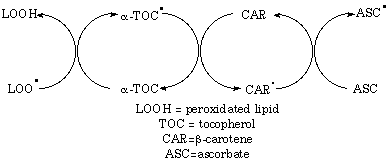
Fig. 9 - Synergic interplay of ascorbic acid, carotenoids and tocopherols in the protection of lipid fats against oxidation.
However, it is important to recall that what has been observed in vitro, may not be automatically transferred to the living systems, as a matter of fact Walther et al. (27) showed that the addition of vitamin E to antioxidant liposomes delivered to fetal lungs significantly reduced the surface activity, and then it may not represent a suitable approach to perform radical scavenging in vivo.
Moreover, the current increasing amount of radical species that are present in the atmosphere (particularly nitrogen oxides), the seasonal partial loss of the ozone layer, and then the increase of the ultraviolet irradiation over the Earth, are all related problems that show the importance of using antioxidant species in protecting the body from the free radicals' attacks, or in minimizing their dangerous activity (28,29). On the other hand we must be aware that the fashionable habit of large intakes of ascorbic acid and its derivatives on a regular basis may represent a serious hazard to the human health, for the possible consequences of producing radicals directly into the body, for instance through the reaction with metal ions such as iron and copper (14).
A huge list of patents already reports several preparations, based on ascorbic acid or on its organic derivatives. Many academic and industrial Laboratories have studied the properties of lotions, creams, drugs, and cosmetic products with the aim of improving the antioxidant protecting activity of tocopherols by adding ascorbic acid or its derivatives, and of widening their applications and uses. Some of these systems require the use of both aqueous and hydrophobic phases, emulsionated with a proper amount of surfactants (30-32). Other compounds, like 3-alkyl-ascorbic acids, have been tested as antioxidants and found to be very strong chain-breaking agents with a high affinity for biomembranes, suggesting that some lipophilic derivatives of ascorbic acid could be of benefit for protection against reperfusion injury (18). Moreover, 3-O-alkyl-ascorbic acids were found to be stable in ointments and to suppress intracellular melanin accumulation in the skin (17). The effect of 3-alkyl-ascorbic acids has been reported by Nihro et al. (33).
Other studies indicate that 6-O-ascorbyl-alkanoates are much more active in preventing oxidation of linoleic acid than ascorbic acid in SDS, Triton, and CTAB micelles (34,35), despite the fact that ascorbic acid-palmitate and ascorbic acid show a similar efficiency in homogeneous solutions. In the case of a lipophilic derivative of ascorbic acid such as ascorbic acid-palmitate, the electrostatic interactions with the polar headgroups of the surfactants (the cationic CTAB or the anionic SDS) are no longer relevant for its antioxidant properties. Another interesting difference between ascorbic acid and its lipophilic derivatives is that in the case of vitamin C the maximum rate is reached for SDS or CTAB concentrations above the CMC, whilst in the case of ascorbic acid-palmitate the rate decreases with increasing surfactant concentration. This may be due to the inter-micellar diffusion dynamics that contributes to the rate-limiting step. The same finding was obtained studying vitamin E in SDS micelles. These results demonstrate that the inter-micellar diffusion is one of the main factors that affect the antioxidant activity and does depend on the lenght of the hydrophobic chain.
The antioxidant synergism of vitamin E and vitamin C has been recognized and extensively studied. The key step is the reaction between the tocopheroxyl radical (TOC·) and vitamin C (ASC):
TOC· + ASC- = TOC + ASC· [1]
introducing a lipophilic chain in position 5 or 6 in vitamin C does not change its reactivty toward TOC· in homogeneous solutions, but the rate constant for reaction [1] is lowered by a factor 10 in the presence of phosphatidylcholine liposomes. In this case the lipophilic vitamin C derivative may either reside in the same or in a different micellar structure than that where the TOC· radical is, in the latter case therefore it must diffuse out from its micelle before reacting with TOC·, and then the total rate constant would depend on the lenght of the side chain. The most interesting insight is that a liposome fusion mechanism must be invoked to rationalize the antioxidant activity in vesicles. Liposomes are dynamically stable systems below the transition temperature due to the tremendous hydration repulsion force against the get-together of two liposomes. However, fusion could be induced by some ionophores or fusogens, such as Ca2+ which may form a bridge between two liposomes facilitating the fusion. The incorporation of ascorbic acid-derivatives into lecithin liposomes would make the liposomal surface negatively charged. Of course attractive electrostatic interactions between oppositely charged liposomes would serve as a driving force to induce the fusion. The intraliposomal diffusion may also contribute, because subsequent to the liposome fusion the two substrates must subject to fast lateral intraliposomal diffusion to find each other for the reaction to occur. Preliminary biological assays have been performed to check if the same findings occur in the case of biomembranes. The antioxidant activities of octanoyl- and palmitoyl-ascorbic acid are much better than that of ascorbic acid and tocopherol, both in vivo and in vitro. An interesting observation is the delicate balance played by the lenght of the side hydrophobic chain, in fact longer alkyl segments facilitate the insertion of the ascorbic acid derivative into the bilayer, but they also make the interfacial diffusion more difficult. Lauroyl-ascorbic acid seems to be the best agent in that sense (15).
Similar conclusions were drawn by Liu et al. (36) in their study on the antioxidant activities of ascorbic acid and ascorbyl-palmitate, carrying out ESR measurements on bilayered vesicles made up of an anionic surfactant (SPHS = 1-pentadecyl hexadecyl sulphate) and a stable lipophilic nitroxide probe (TEMPO-16). The results indicate the occurrence, in the case of ascorbic acid, of a two-step reaction that first involves the external vesicle surface that interacts with vitamin C dissolved in the aqueous bulk phase, and only in a second time the TEMPO molecules that are confined in the inner layer will enter into the aqueous medium after a flip-flop diffusion motion across the membrane. On the other hand, when palmitoyl-ascorbic acid is directly incorporated into the SPHS vesicles a much fast reaction occurs, that can be explained, again, with a vesicle fusion mechanism.
The radical attack operated by an initiator usually follows the following general path (37,38):

As radical initiator the following molecules are mostly used, depending on the medium where the reaction is going to be taken: DPPH (alpha,alpha-diphenyl-beta-picrylhydrazyl), water soluble; AMVN (2,2'-azobis(2,4-dimethyl-valeronitrile)), oil soluble; AAPH (2,2'-azobis(2-amidinopropane)dihydrochloride), water soluble;AIBN (2,2'-azobisisobutyronitrile), oil soluble; DBHP (di-tert-butyl hyponitrite), water soluble.
Fig. 10 shows that ascorbic acid esters incorporated into phospholipid vesicles (liposomes) significantly suppress the oxidation of the unsaturated components, and produce an induction period, after which the peroxidation proceeds with the same slope as in the absence of the radical scavenger (39).
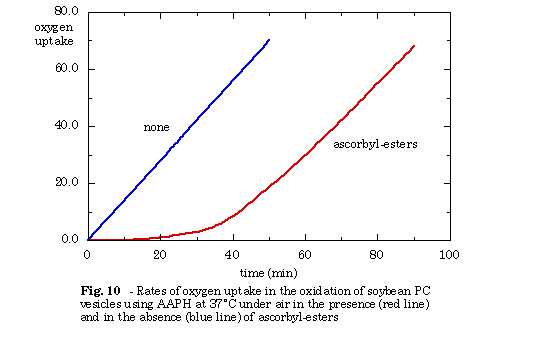
The next plot (Fig. 11) shows the time dependence of absorbance when a solution of linoleic acid is first treated with some radical initiator (AIBN or DPPH, depending on the solvent medium), and then with some radical scavenger. The curve indicates that as soon as the radical promoter is added, the unsaturated fatty acid is attacked and forms the conjugated diene that absorbs at 234 nm (38,40). The radical scavenger momentarily stops the peroxidation of linoleic acid until it is completely consumed as the second plateau indicates, and then the oxidation starts again with the same kinetic as before (38,39).
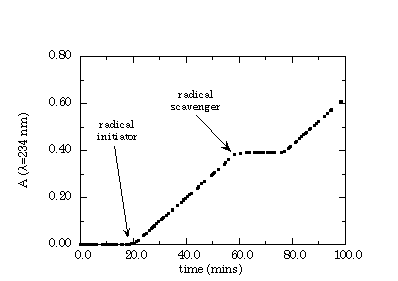
Fig. 11 - The oxidation process of linoleic acid can be monitored by measuring the absorbance at 234 nm as a function of time. The arrows indicate the addition of the radical initiator and of the radical scavenger to the solution.
The antioxidant activity of different natural and synthetic chemicals is a very important property, especially for industrial applications. A simple method to evaluate such parameter consists in measuring the absorbance before and after the addition of each antioxidant to an ethanolic solution of a proper radical initiator, such as DPPH (see structure below). This radical promoter is deeply colored (purple) and absorbs at 517 nm. The addition of an antioxidant agent determines the fading of its color, and the rate is related to the efficiency of the radical scavenging. The reducing activity (RA, %) can be easily derived from the following equation:
where A(0) and A(20) are the absorbance values (at 517 nm) before adding the reducing agent and 20 minutes after its addition, respectively (33,41). Some products have been tested according to this procedure, and the results are shown in Fig. 12.
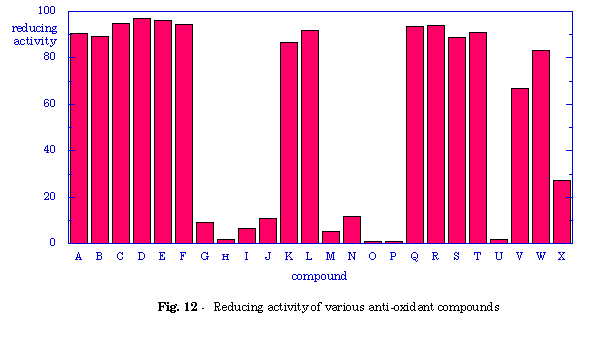
It is interesting to note that ascorbic acid, 6-O-alkanoyl-ascorbic acids (A thru F), and 5,6-octylidene-ascorbic acid (L) possess more or less the same reducing activity as determined with this colorimetric method. Their radical scavenging performances are comparable or even larger than those of some natural products such as tocopherol (K), caffeic acid and some components of naturali olive oils. Furthermore, it is important to observe that the most active natural products possess two OH phenolic groups in position orto: this chemical structure can be easily compared to the presence of the two OH groups in ascorbic acid on both sides of the double bond. The two-headed derivatives (G thru J) show an almost negligible activity, as well as the fluorinated compounds (M).
Vitamin C and its derivatives readily react with oxygen in aqueous solutions, and the reaction can be easily monitored by measuring the concentration of oxygen with an electrode. The following plot (Fig. 13) refers to some experiments where the amount of dissolved oxygen was measured in three different 1 mM solutions of ascorbic acid, 6-O-octanoyl ascorbic acid, and 6-O-decanoyl-ascorbic acid, at 37°C (9). The values are corrected for the local pressure and temperature.
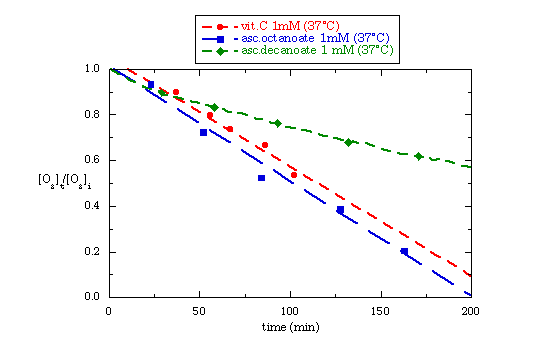
Fig. 13 - Oxygen consumption measured with an O2 electrode in water solutions of ascorbic acid, ascorbyl-octanoate and ascorbyl-decanoate as a function of time.
The data show that the anti-oxidant properties of octanoyl-ascorbic acid and of vitamin C are almost the same, with a slight higher efficiency of the lipophilic derivative. In the case of decanoyl-ascorbic acid the anti-oxygen activity is retained, but with a low

0 comments:
Post a Comment